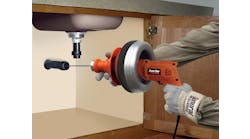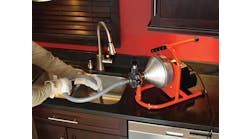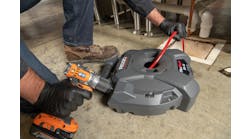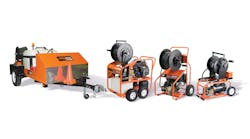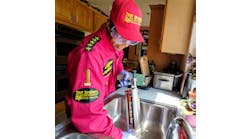Drains clog! Regardless of the economy or the time of year. And when they do, you need to have the right tool to get the water flowing again. The right one will clean the line quickly and leave you with a happy customer. The wrong one will leave you with an unhappy customer at best and, at worst, a damaged machine and an injured customer.
It's important to know the tools' capabilities and match them to customers' needs. When they walk in the door and say, "I need a drain-cleaning machine" or "I've got a clogged drain; give me the cheapest thing you've got," ask a few questions to figure out which tool is most likely to solve the problem: Which drain is clogged? The kitchen sink? The toilet? The whole house?
If just one drain is clogged, the problem is probably limited to the small drains where a handheld or small floor model will do. If the tub, sink and toilet are clogged, the problem is likely to be in the large line leading out of the house. For that, a larger floor model machine would be the right tool for the job. If customers try to clear a large line with a small machine, they could easily damage the machine.
The following guide to tool selection will help to find the right tool for a particular job. Sometimes several tools can do the same job.
Both cage-type and sectional-type machines are available in the large machine category. Each has advantages: The cage-type machines are self-contained and easier to operate. The sectional machines are lighter. Consulting with local contractors to see what they are using can be helpful before you buy.
Which is easier to rent to a customer: hand tools or power tools? For the smaller jobs, both types of tools are available. Electric machines are faster and much more powerful than hand tools. They are easier to operate and get the job done faster. But hand tools are less likely to get damaged in the hands of an unskilled operator. Have some hand tools for customers who do not seem to have the mechanical aptitude to handle an electric machine.
The best tool for clearing a clogged toilet is the closet auger. No other tool in your arsenal will go through the bowl as quickly and easily.
The best tool for clearing a clogged or slow-draining tub is a water ram. Tubs often drain through drum traps that are very difficult to get through with a cable. The water ram creates a shock wave that follows the path of the water and isn't affected by tight bends and narrow lines. It travels down the line and knocks out the stoppage without harming the pipes. The water ram also works well on trailer homes that can be difficult to clear using cables because they have narrow drain lines with tight bends.
Cable is key It is impossible to rent the correct tool if it is not in inventory. When purchasing drain-cleaning tools for your rental fleet, you must first look at the most important part of the tool - the part that gets the most use and abuse - the cable. The cable does all of the work. It has to be strong enough to withstand abusive situations and customers. That's why all the machines should have left-hand-wound inner-core cables rather than hollow cables.
When a customer gets the cable caught on a root or around a tight bend, the end of the cable stops turning. But the other end of the cable, closest to the machine, is still turning because the operator doesn't know the cable is stuck. What happens? In a hollow cable, the coils wind up and will kink quickly and break. If you get in the same situation with an inner-core cable, the core inside can support the coils as they start to collapse.
Don't overlook safety The next thing to look at is safety. Consider buying the safest machines possible and upgrading existing machinery.
Electrical safety is a prime example. Electricity and water don't mix. Yet you've got an electric drain cleaner that's used in water. The most important item on every machine should be a ground-fault circuit interrupter. If there are any electrical problems such as a cut in the power cord, this unit will detect the current leakage and shut the machine down.
Air-activated foot pedals are also important. You've got water on the floor. You don't need electricity there, too. The air foot pedal uses air pressure to activate the switch and keeps all wiring off the floor.
Safety slip clutches are yet another feature to look for when purchasing a drain cleaner. An untrained operator can twist a cable to the point where it will buck and whip, causing damage to the cable and possibly harming the operator. A slip clutch can stop the cable rotation before the operator gets into trouble, saving the cable and the operator's fingers, too.
Leather gloves are an absolute necessity when operating a drain cleaner. Cotton gloves can get caught in the coils of the cable as it's spinning and cause severe hand injury. Any rental of a drain cleaner should include leather gloves.
Another part of safety is good instruction and training, because a properly trained customer is likely to be a safe customer.
The high cost of plumbers, combined with the fact that drains will always clog, virtually guarantees you profits from the rental of drain-cleaning tools - if you provide the right tool for each job.
For grease, sand or ice, nothing clears the line faster than a jet. High-pressure water jets have grown in popularity among professional drain cleaners in recent years. Now they're getting hot in the rental industry.
When a snake goes through grease, the grease will close up behind the cable and still leave the line clogged. A water jet uses high-pressure water to flush away such sticky clogs as grease that cable machines have a hard time clearing. However, jets don't replace cable machines because they can't clear such heavy stoppages as tree roots.
If you are in a cold climate, jets can be used to clear lines clogged with ice. The larger gas jets can clear a foot of ice per minute in a 4-inch line. Jetters work well in both plastic and metal pipe.
If you rent to restaurants, factories and institutions where grease clogs are a constant problem, jets are ideal. They have been a popular rental item with plumbing contractors as well. Contractors will often rent from you rather than buy their own jetter.
But jets are not for everyone. They require more instruction than cable machines. For instance, a jet sprays most of the water backward to pull the hose down the line. This means you'd better get the hose around the first bend before you turn the machine on or you'll have a geyser shooting out of the drain.
When you're buying a jet, make sure it has a pulsation device - it makes the hose vibrate to overcome the friction in the line so it will slide easily down the drain. Without it, the hose has a hard time getting around tight bends and is very likely to get stuck. Your jet machine should also have a backflow-prevention device to keep sewer water from getting into the freshwater supply.
